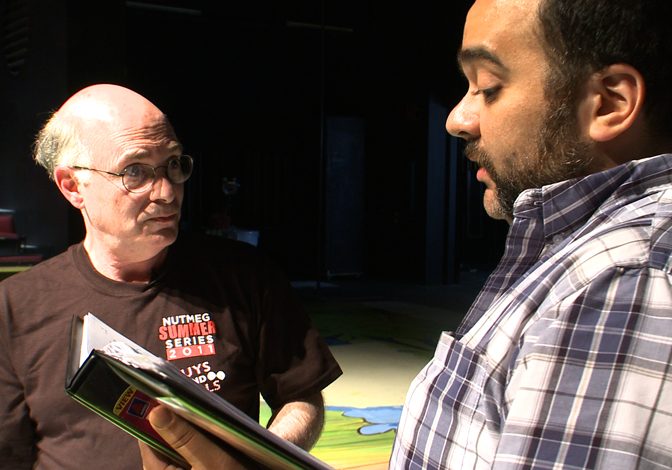1. WHEN ACTING, DON’T MAKE YOUR ACCENT HARD TO UNDERSTAND.
When acting with accents on stage or screen, it doesn’t matter how authentic you sound if you can’t be understood. Yes, I know that some real-world accent speakers are in fact difficult for many to understand. That doesn’t make it acceptable to for audience members to miss important lines and plot points. Your goal should be to combine the impression of authenticity with total intelligibility.

Consider the SCOTTISH ACCENT. Some Glaswegian and Border Scots are difficult to understand for many English speakers, even some in the UK. But natives of Edinburgh and Inverness, for example, are typically more intelligible to outsiders. I often relate a story from the first time I coached Brigadoon. I could hardly understand a single authentic-sounding word spoken by the actor playing Mr. Lundie. Neither the director nor I had any success asking or insisting that he modify it. Unfortunately, the producer did not replace him. So, few audience members understood his pivotal explanation of why the town appeared out of the highland mist only once every hundred years. Actors tell stories on the stage and screen. Audience members should be able to follow those stories.
2. DON’T FOCUS ONLY ON YOUR ACCENT’S PRONUNCIATION CHANGES.
My earliest accent-coaching attempts failed. Once I realized that most actors did not share my ability to imitate, I looked for a more systematic method. I next had them modify pronunciation—changing their native vowels and consonants to those of the target accent. The results were almost as bad. For example, even following my directions to “change Long-A to Long-I and Long-I to OY,” most still failed to create Cockney-sounding words and phrases. After a long exploration of my own accent-imitation skills, I discovered there were speech traits other than pronunciation that I changed from accent to accent. Without the presence of those traits, technically “correct” pronunciations often sounded fake or disconnected. So, what are those traits? Every accent has a unique resonance (or voice placement or timbre). These traits result from differences in the shape or posture of the vocal tract (mouth, nose, throat, etc.) In addition, some accents have lilts or inflections on stressed syllables. I strongly believe these traits must be learned before (but NOT instead of) producing target vowels and consonants.
3. DON’T BE INCONSISTENT WHEN ACTING WITH ACCENTS!
Accent inconsistency is often extremely annoying to audiences. Avoid being erratic with several elements of the accent . First, maintain the target pronunciations—especially those recognized and expected by many audience members. For example, the Cockney “FACE Vowel” sounds like the General American or RP “PRICE Vowel.” Land it every time! Don’t do it once or twice before falling back toward your typical pronunciation. Also, avoid moments when your character’s accent diminishes or disappears. Of course, having a director with a good ear or an accent coach at rehearsals will help you avoid this. But the advice in Item #2 above also helps avoid this problem. You’re more likely to maintain the overall accent and its phoneme consistency if you always start with the basics. Use the accent’s resonance/muscularity and inflections to express thoughts, paint images, and physicalize actions.
Here’s another aspect of inconsistency that can drive audiences crazy. In musicals (sometimes at the insistence of music directors), actors often reduce or abandon accents when singing. The rationale is often that “pure musical tones” cannot be sustained through a given accent’s vowels. But, to keep an audience engaged with the story and relationships, characters must continue being the same people whether speaking or singing. Here are my two “truths” for accents in musicals: (1) Singers can still support the voice while the mouth posture supports an accent’s resonance and vowels. (2) The choice to sacrifice character inevitability for pure musicality is usually a bad one. Characters must live and interact through songs, not just sing them. Or, as my late teacher and colleague Nafe Katter often said, “A song mustn’t just be sung; it must be sold.”
4. DON’T LET YOUR ACTING BE ABOUT YOUR ACCENT!

Too many actors, I sometimes joke, apply Stanislavski’s terms the wrong way when acting with accents. Their objective is “to sound Irish in the scene.” Their super objective is “to sound Irish for the whole play.” No! When acting with accents, characters’ objectives and actions must still grow from their backgrounds, relationships, and given circumstances. This moment-to-moment inner process is as important (perhaps more important) when actors aren’t speaking with their native patterns. Your character’s accent becomes the new vocal medium for playing the same acting elements you’d use for a non-accent role. Any character, regardless of accent, must still connect with others, pursue objectives, paint images, and land actions. In auditions, rehearsals, and performances, newly learned accents too often dilute many of those things. I’ll long remember auditioning decades ago for a production of Anouilh’s Becket. I had just completed a monologue by the title character. The director said, “Try it again, David. This time find at least one thing he’s doing other than sounding English.”
5. DON’T LET A MONOTONE ACCENT IMPEDE YOUR ACTING!
Some accents typically employ more vocal variety than others. For example, the Bronx style of NEW YORK CITY speech (think Garry and Penny Marshall) typically has very few pitch changes. The same is often true of West Texas speech and the accents of languages like GERMAN and ARABIC. To some, these accents simply don’t sound “real” if spoken with noticeable pitch variety. BUT I (and many other voice/text coaches) believe vocal variety is essential to reflect and reinforce characters’ changing intentions and actions. So, we seek ways to combine some pitch variety (for artistic reasons) while keeping a monotone impression (for accent identity). Here’s my solution. When acting with those accents, let phrases or thought units remain monotone. BUT, when your character finds a new idea in the next phrase, switch to a higher or lower note. Rule of thumb: Don’t begin two consecutive phrases (or make consecutive discoveries) at the same pitch.
6. DON’T LET AN ACCENT’S INFLECTIONS IMPEDE YOUR ACTING!
When confronted with an accent that has a strong inflection or lilt, native speakers often get into a repetitious pattern. That’s especially true of accents with upward lilts (Liverpool, Northern IRISH, SCOTTISH, JAMAICAN) or up-down lilts (AMERICAN SOUTHERN, NORWEGIAN, Minnesotan). Actors often overly emphasize such patterns, perhaps subconsciously trying to “prove they’re doing the accent.” But that’s not your job as an actor. You mustn’t SHOW these lilts as accent markers. Instead you should embrace those traits as TOOLS the characters USE for framing words, making points, and landing actions. Here’s one technical suggestion that can help this along. When speaking with these lilting accents, avoid using the same starting and ending pitch on each lilting word. Discover and use new operative words at different pitches.
7. DON’T LET YOUR ACCENT MAKE ACTING CHOICES FOR YOU.
When acting with accents, don’t let speech patterns dictate that characters have specific personalities or are inclined toward certain choices. . Not all New York accent speakers are rude and aggressive. Neither are all IRISH speakers jovial, nor are all speakers of ENGLISH RECEIVED PRONUNCIATION snobbish because of their accents. Also, when acting with accents, don’t let them dictate a character’s level of intelligence. Characters channel thoughts and energize actions with their speech patterns. But those thoughts and actions come from individual personalities, relationships, and given circumstances. When acting with an accent, don’t let your character’s accent reduce your options or dictate your choices.
8. DON’T ALWAYS INSIST ON AN ACCENT’S GEOGRAPHICAL PURITY.

When I began researching and coaching accents, I tried to be a “geographic dialect purist.” That is, I wanted actors to nail the sound of the exact PART of BOSTON (or New York or Ireland or Germany, etc.) their characters were from. Certainly, there are some dramatic situations in which that degree of purity could be appropriate. However, I now agree with many directors that artistic choices can and often should override an accent’s geographic “correctness.”
Here are a few of those legitimate concerns. Some accents are so unknown to and unidentifiable by most audience members, they could end up being confusing and distracting. How many Americans know or relate to a Belfast or Donegal accent? How would many UK residents respond to realistic Philadelphia or St. Louis speech? Even if theatre programs included dramaturgical notes about the unfamiliar accents, how many would read and absorb them pre-curtain? AND, are certain regional sounds so aesthetically displeasing to many ears that they’d create barriers between audience and characters? Suffice it to say that after 40+ years of accent coaching, I can now support directors’ choices to violate accent purity for artistic or aesthetic reasons. However, this is such a controversial and intriguing issue that I will devote a whole future blog post to it.
In addition to the audio lessons available on the website (www.LearnAccent.com), David Alan Stern is also available for:

Distance Lessons (Skype or Zoom)